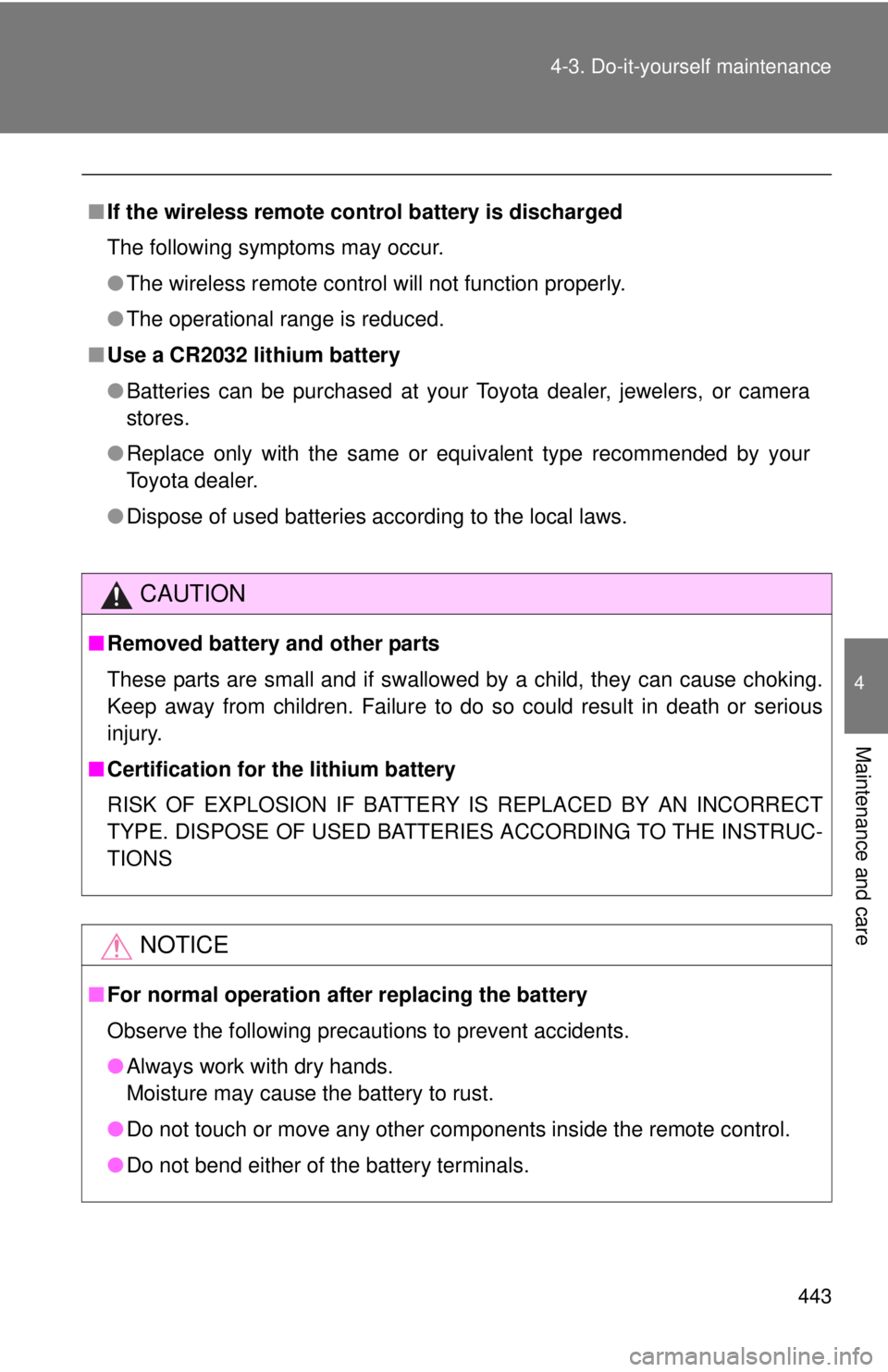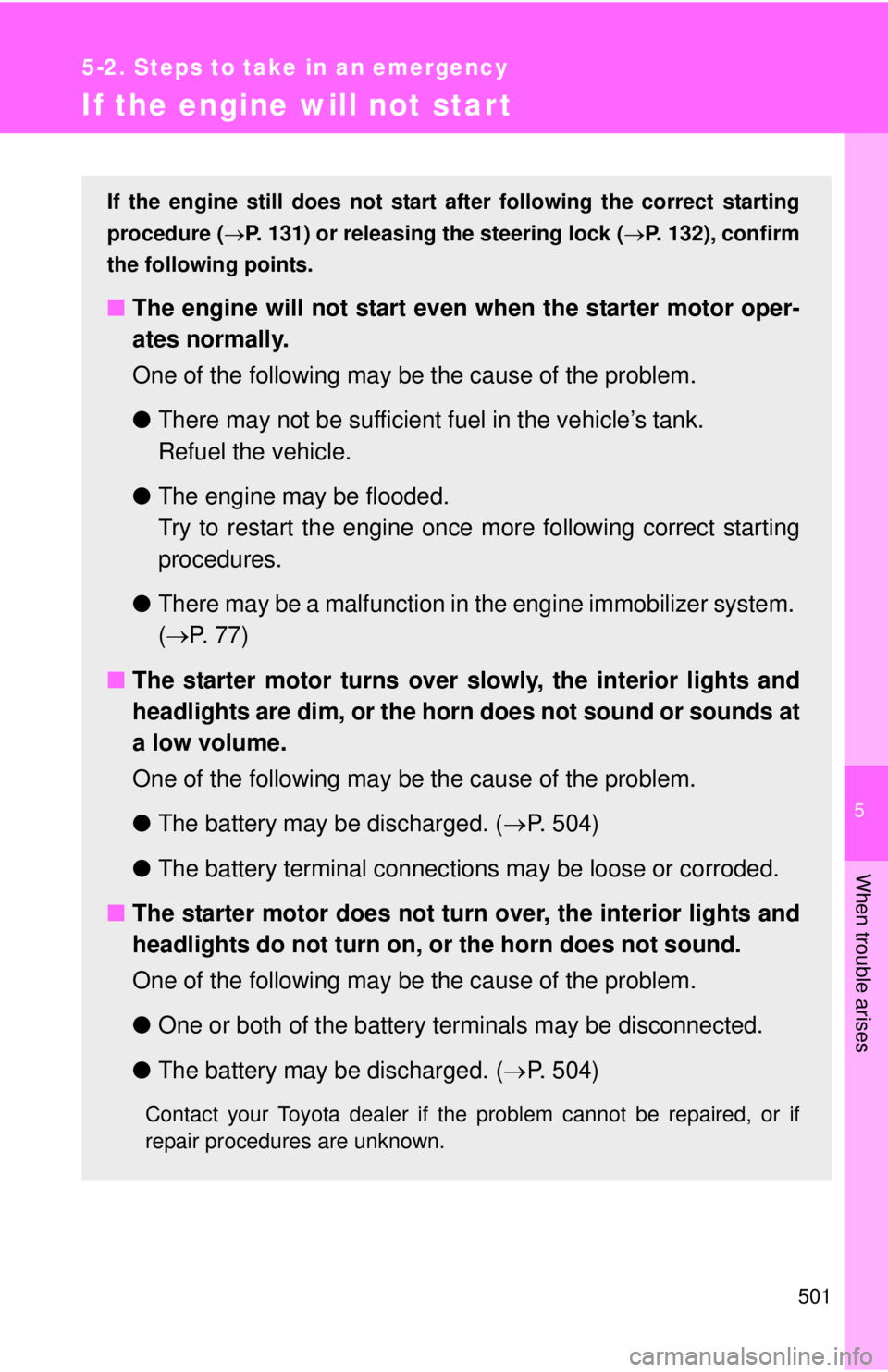Page 420 of 590
420 4-3. Do-it-yourself maintenance
Washer fluidIf the washer does not work, the washer tank may be empty.
Open the lid.
Add washer fluid.
NOTICE
■When recharging the battery
Never recharge the battery while the engine is running. Also, be sure all
accessories are turned off.
CAUTION
■When refilling the washer fluid
Do not refill the washer fluid when the engine is hot or running, as the
washer fluid contains alcohol and may catch fire if spilled on the engine etc.
Page 442 of 590
442
4-3. Do-it-yourself maintenance
Wireless remote control batter y
: If equipped
Replace the battery with a new one if it is discharged.
■You will need the following items:
Lithium battery CR2032
■ Replacing the battery
Remove the cover using a
coin protected with tape etc.
Remove the discharged trans-
mitter battery.
Insert a new battery with the
“+” terminal facing up.
Page 443 of 590

443
4-3. Do-it-yourself maintenance
4
Maintenance and care
■
If the wireless remote control battery is discharged
The following symptoms may occur.
●The wireless remote control will not function properly.
● The operational range is reduced.
■ Use a CR2032 lithium battery
●Batteries can be purchased at your Toyota dealer, jewelers, or camera
stores.
● Replace only with the same or equivalent type recommended by your
Toyota dealer.
● Dispose of used batteries according to the local laws.
CAUTION
■Removed battery and other parts
These parts are small and if swallowed by a child, they can cause choking.
Keep away from children. Failure to do so could result in death or serious
injury.
■ Certification for the lithium battery
RISK OF EXPLOSION IF BATTERY IS REPLACED BY AN INCORRECT
TYPE. DISPOSE OF USED BATTERI ES ACCORDING TO THE INSTRUC-
TIONS
NOTICE
■ For normal operation after replacing the battery
Observe the following precautions to prevent accidents.
●Always work with dry hands.
Moisture may cause the battery to rust.
● Do not touch or move any other components inside the remote control.
● Do not bend either of the battery terminals.
Page 448 of 590

448 4-3. Do-it-yourself maintenance
FuseAmpereCircuit
1 A/C 10 A Air conditioning system
2 TOWING TAIL 30 A Trailer lights (tail lights)
3 FOG FR 15 A Front fog lights
4 STOP 10 A Stop lights, high mounted stop-
light, vehicle stability control sys-
tem, anti-lock brake system, shift
lock system, multiport fuel injection
system/sequential multiport fuel
injection system, towing lights
5 TOWING BRK 30 A Trailer brake controller
6 EFI 10 A Multiport fuel injection system/
sequential multiport fuel injection
system
7 S/HTR NO.2 30 A Seat heaters
8 OBD 7.5 A On-board diagnosis system
9 BATT CHG 30 A Trailer sub battery
10 AIR PMP HTR 10 A AI system
11 TOWING 30 A Towing lights
12 TURN & HAZ 15 A Turn signal lights, emergency
flashers, meter and gauge
13 RADIO NO.2 30 A Audio system
14 H-LP RH-LO 10 A Right-hand headlight (low beam),
front fog lights
15 H-LP LH-LO 10 A Left-hand headlight (low beam)
16 H-LP RH-HI 10 A Right-hand headlight (high beam)
17 H-LP LH-HI 10 A Left-hand headlight (high beam),
meter and gauge
18 ETCS 10 A Multiport fuel injection system/
sequential multiport fuel injection
system, electronic throttle control
system
Page 465 of 590
When trouble arises5
465
5-1. Essential informationEmergency flashers ......... 466
If your vehicle needs to be towed ........................ 467
If you think something is wrong ............................. 474
Fuel pump shut off system ........................... 475 5-2. Steps to take in
an emergency
If a warning light turns on or a warning buzzer
sounds... ........................ 476
If you have a flat tire......... 486
If the engine will not start ................................ 501
If the shift lever cannot be shifted from P (vehicles
with an automatic
transmission) ................. 502
If you lose your keys ........ 503
If the vehicle battery is discharged ..................... 504
If your vehicle overheats ....................... 508
If the vehicle becomes stuck .............................. 511
If your vehicle has to be stopped in
an emergency ................ 513
Page 466 of 590
466
5-1. Essential information
Emergency flashers
NOTICE
■To prevent battery discharge
Do not leave the emergency flashers on longer than necessary when the
engine is not running.
Use the emergency flashers if th e vehicle malfunctions or is
involved in an accident.
Press the switch to flash all
the turn signal lights. To turn
them off, press the switch
once again.
Page 501 of 590

5
When trouble arises
501
5-2. Steps to take in an emergency
If the engine will not star t
If the engine still does not start after following the correct starting
procedure ( P. 131) or releasing the steering lock (P. 132), confirm
the following points.
■ The engine will not start even when the starter motor oper-
ates normally.
One of the following may be the cause of the problem.
●There may not be sufficient fuel in the vehicle’s tank.
Refuel the vehicle.
● The engine may be flooded.
Try to restart the engine once more following correct starting
procedures.
● There may be a malfunction in the engine immobilizer system.
( P. 7 7 )
■ The starter motor turns over slowly, the interior lights and
headlights are dim, or the horn does not sound or sounds at
a low volume.
One of the following may be the cause of the problem.
●The battery may be discharged. ( P. 504)
● The battery terminal connec tions may be loose or corroded.
■ The starter motor does not turn over, the interior lights and
headlights do not turn on, or the horn does not sound.
One of the following may be the cause of the problem.
● One or both of the battery terminals may be disconnected.
● The battery may be discharged. ( P. 504)
Contact your Toyota dealer if the problem cannot be repaired, or if
repair procedures are unknown.
Page 504 of 590
504
5-2. Steps to take in an emergency
If the vehicle batter y is discharged
The following procedures may be used to start the engine if the
vehicle’s battery is discharged.
You can call your Toyota dealer or qualified repair shop.
If you have a set of jumper (or boo ster) cables and a second vehi-
cle with a 12-volt battery, you can jump start your Toyota following
the steps below.
Connect the jumper cables.
2.7 L 4-cylinder (2TR-FE) engine